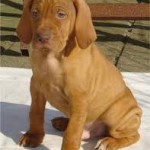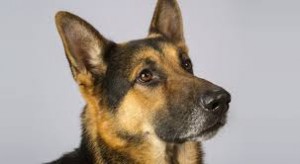-
This breed is often described as the “Velcro Vizsla.” Most dogs are affectionate, but this medium-size hunting dog is especially attached to his people.
His Velcro nature has to do with his past: the Vizsla was developed in Hungary to be both a pointer and retriever who would work close to the hunter, never ranging too far away. That trait is still seen in today’s Vizsla, who prefers to be leaning against your leg or serving as a footwarmer. If having a dog shadow you all day would annoy you, choose a different breed.
Despite their penchant for sticking close to their human pals, Vizslas are versatile and hard-working dogs who are happiest when they have a job to do. In a family, that job can be hunting companion, therapy dog, or jogging buddy. Give him at least an hour of exercise per day, and the Vizsla will be your best friend.
If you’re interested in dog sports and activities, your Vizsla would probably be happy to compete. The Vizsla is the first and so far only breed to produce a quintuple champion — in conformation, field, obedience and agility. His superb scenting skills make him a natural hunter. Vizslas have also been guide dogs, drug-detection dogs, therapy dogs, and search-and-rescue dogs, and have competed in falconry, flyball, tracking, and hunt tests.
Whatever you do with your Vizsla, train this sensitive dog with kindness and positive reinforcement. He’s quick to learn, and his keen senses and protective instinct make him an excellent watchdog.
Vizslas are talkers, and will whine, moan, or make other noises to let you know their opinion on everything that’s going on. Some can become recreational barkers if this habit isn’t controlled early on.
Not surprisingly, the best home for a Vizsla is one in which someone is there during the day to keep him company and give him the activity and mental stimulation he needs. Without them, he can become bored and destructive. With the right family, however, he’s a lively, loving, gentle friend who will return tenfold the love you give him.
-
Highlights
- Vizslas are an active breed and need at least 60 minutes of exercise every day. They enjoy long walks, jogging, and playing fetch, as well as dog sports.
- Vizslas are low to moderate shedders and need only weekly brushings to keep them free of loose hair. They rarely need baths and don’t have a strong doggy odor.
- Vizslas thrive on human companionship. They’ll follow family members from room to room and like to be touching or touched by their people.
- Vizslas aren’t recommended for people who work long hours. Vizslas can suffer from separation anxiety, which can lead to destructive behaviors.
- Vizslas tend to be chewers. Keep your Vizsla supplied with plenty of chew toys to protect your possessions.
- Vizslas do best in homes with fenced yards where they can safely run and play.
- Vizslas should live in the home with the family, not outside. Their coat doesn’t protect them from cold temperatures and they can’t thrive without human companionship.
- Although they aren’t recommended for homes with young kids, Vizslas are very affectionate with children and can make great companions for older, energetic kids.
- Training and socialization is a must with this breed. They can be difficult to handle if they aren’t properly trained and they can become shy and timid if they’re not properly socialized.
- Vizslas do well with other dogs and will even get along with cats if they’re raised with them. However, they’re not a good fit for homes that have small pets such as rabbits, gerbils, guinea pigs, or birds.
- To get a healthy dog, never buy a puppy from a puppy mill, a pet store, or from a breeder who doesn’t provide health clearances or guarantees. Look for a reputable breeder who tests her breeding dogs to make sure they’re free of genetic diseases that they might pass onto the puppies and breeds for sound temperaments.
- If you’re buying a puppy, meet the puppy’s parents — they’re an indicator of what your pup’s future personality might be like. They should be friendly and sociable, not high-strung or overly shy.
-
History
Sometimes known as the Hungarian Pointer, the Vizsla probably descends from hunting dogs used by the Magyars, who settled Hungary more than a thousand years ago. The dogs were no doubt used by nobles and warlords to hunt game birds and hares. Eventually, the dogs were developed to both point and retrieve.
Images of the Vizsla’s past can be found in ancient art. A 10th century etching shows a smooth-coated dog accompanying a Magyar huntsman. A chapter on falconry in a 14th century manuscript depicts a Vizsla-shaped dog.
By the 19th and early 20th century the Vizsla was a distinct breed with excellent scenting powers who worked closely with his handler. During World War I, the talented hunting dog was used to deliver messages.
The aftermath of World War I, followed by the ravages of World War II, nearly brought an end to the breed, however. Fortunately, the Vizsla managed to survive, and the first members of the breed were imported to the United States in the early 1950s.
At that time, the breed looked much different than today: they had longer muzzles and a bonier topskull. Some had a houndy appearance, with long ears, and others ranged in color from chocolate brown to almost bleached out.
The Vizsla Club of America was formed in 1954 and the American Kennel Club recognized the breed in 1960. Breeders have worked to standardize the distinctive Vizsla appearance and aristocratic bearing that you see today.
Today the Vizsla is a beloved companion who can be found performing a multitude of jobs. Some were even working at Ground Zero after the terrorist attacks of September 11, 2001.
The breed is moderately popular, ranking 43rd among the 155 breeds and varieties recognized by the American Kennel Club.
-
Size
This is a lightly built, medium-size dog, with males standing 22 to 24 inches at the shoulder, females 21 to 23 inches. The weight range for the breed is 45 to 65 pounds, with females being smaller.
-
Personality
The Vizsla is described as lively, gentle, and affectionate, with above-average learning ability and a strong desire to be with people. He’s known for being biddable, but there are always exceptions — some Vizslas can be stubborn, excitable, or shy.
Energetic and athletic, the Vizsla can become bored and destructive if left to his own devices. But when he has the training, exercise, and companionship he needs, this eager-to-please dog is hard to beat.
Like every dog, Vizslas need early socialization — exposure to many different people, sights, sounds, and experiences — when they’re young. Socialization helps ensure that your puppy grows up to be a well-rounded dog.
-
Health
Vizslas are generally healthy, but like all breeds, they’re prone to certain health conditions. Not all Vizslas will get any or all of these diseases, but it’s important to be aware of them if you’re considering this breed.
If you’re buying a puppy, find a good breeder who will show you health clearances for both your puppy’s parents. Health clearances prove that a dog has been tested for and cleared of a particular condition.
In Vizslas, you should expect to see health clearances from the Orthopedic Foundation for Animals for hips and thyroid and from the Canine Eye Registry Foundation (CERF) certifying that the eyes are normal.
Because some health problems don’t appear until a dog reaches full maturity, health clearances aren’t issued to dogs younger than 2 years old. Look for a breeder who doesn’t breed her dogs until they’re two or three years old.
The following conditions may affect Vizslas:
- Epilepsy is a disorder that causes seizures. Epilepsy can be managed with medication but it cannot be cured. A dog can live a full and healthy life with the proper management of this disorder.
- Canine Hip Dysplasia is a heritable condition in which the thighbone doesn’t fit snugly into the hip joint. Some dogs show pain and lameness on one or both rear legs, but you may not notice any signs of discomfort in a dog with hip dysplasia. As the dog ages, arthritis can develop. X-ray screening for hip dysplasia is done by the Orthopedic Foundation for Animals or the University of Pennsylvania Hip Improvement Program (PennHIP). Dogs with hip dysplasia should not be bred. If you’re buying a puppy, ask the breeder for proof that the parents have been tested for hip dysplasia and are free of problems. Hip dysplasia is hereditary, but it can be worsened by environmental factors, such as rapid growth from a high-calorie diet or injuries incurred from jumping or falling on slick floors.
- Hypothyroidism is an abnormally low level of the hormone produced by the thyroid gland. A mild sign of the disease may be infertility. More obvious signs include obesity, mental dullness, drooping of the eyelids, low energy levels, and irregular heat cycles. The dog’s fur becomes coarse and brittle and begins to fall out, while the skin becomes tough and dark. Hypothyroidism can be treated with daily medication, which must continue throughout the dog’s life. A dog receiving daily thyroid treatment can live a full and happy life.
- Lymphosarcoma is the third most common cancer seen in dogs and can be found in various parts of the body such as the spleen, gastrointestinal tract, lymph nodes, liver, and bone marrow. The cancer is treated with chemotherapy and approximately 80 percent of dogs treated will go into remission.
- Progressive Retinal Atrophy (PRA) is a degenerative eye disorder that eventually causes blindness from the loss of photoreceptors at the back of the eye. PRA is detectable years before the dog shows any signs of blindness. Fortunately, dogs can use their other senses to compensate for blindness, and a blind dog can live a full and happy life. Just don’t make it a habit to move the furniture around. Reputable breeders have their dogs’ eyes certified annually by a veterinary ophthalmologist and do not breed dogs with this disease.
Read more at http://dogtime.com/dog-breeds/vizsla#PChc5mWTDG75IYic.99



